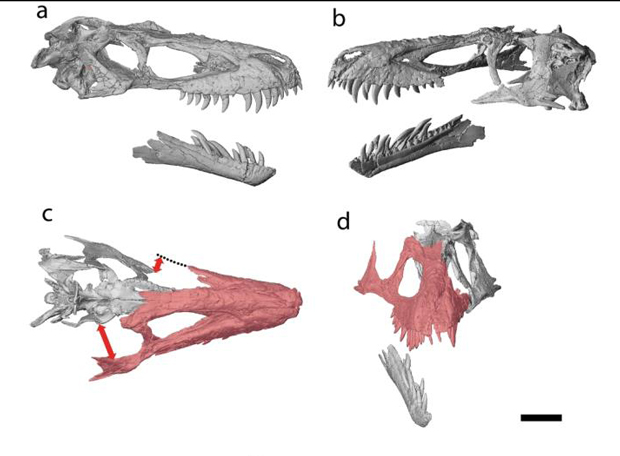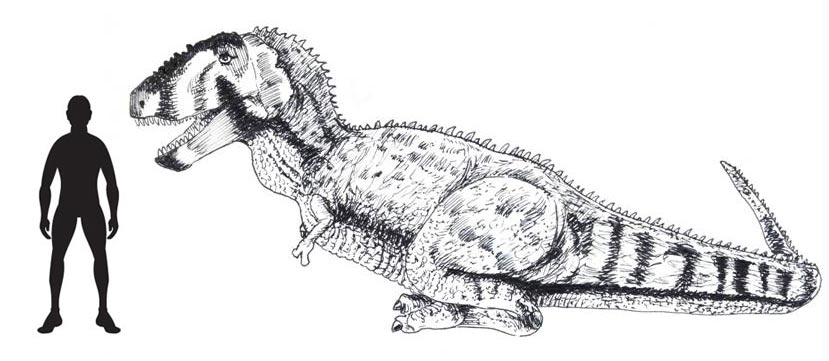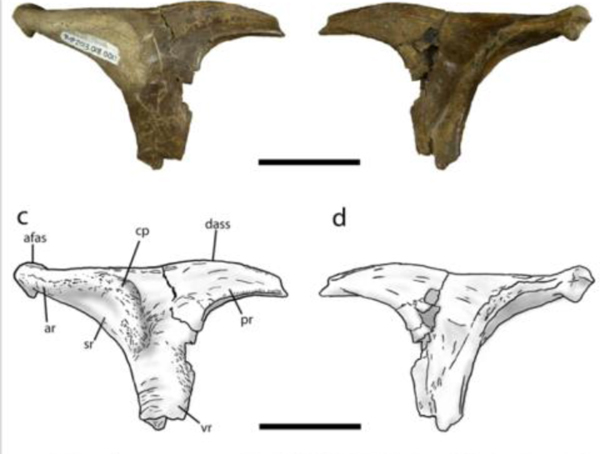New Research Tells Teenage Tyrannosaurs Apart
Fossils From Alberta Help to Tell Teenage Tyrannosaurs Apart
It is often the case that a newly described fossil specimen only leads to confusion and controversy as its details are published. However, a reassessment of a partial skull of a juvenile dinosaur that had been attributed to the tyrannosaurine Daspletosaurus (Daspletosaurus torosus) has now been referred to Gorgosaurus libratus. The finding of a scrap of bone, a part of the skull (postorbital), discovered in the Dinosaur Park Formation of Alberta, was the key to unlocking a mystery when it came to deciphering the fossilised bones of young tyrannosaurids.
Thanks to this new research, identifying which fossils represent different tyrannosaurid species might just have become a little easier.
A Digital Reconstruction of the Skull Elements (TMP 1994.143.1.)

Picture credit: Voris et al/Scientific Reports
TMP 1994.143.1
The partial skull and jaws (specimen number TMP 1994.143.1.), comes from the Dinosaur Provincial Park Formation of southern Alberta. Although the fossil material was well preserved, the fossils were found in a jumbled and disarticulated state. The bones had also been distorted during burial and the fossilisation process (the red shaded elements in the picture above depict the bones affected). This distortion led to the bones becoming slightly wider, thus altering the dimensions of the fossil skull when it was reconstructed by scientists.
The skull length is around sixty-two centimetres whilst other skulls associated with Daspletosaurus torosus measure more than eighty-five centimetres in length, hence TMP 1994.143.1. was thought to represent a juvenile Daspletosaurus.
A Scale Drawing of an Adult Daspletosaurus

Picture credit: Everything Dinosaur
Defining a Juvenile Dinosaur
As scientists have been able to work out the likely growth rates of different dinosaurs, so a definition of what makes a juvenile specimen has emerged. Lead author of the newly published paper, Jared Voris (University of Calgary), explained that juvenile dinosaurs were about half the body length of the largest adult animal known from that species. A juvenile Daspletosaurus would have been around 4 metres in length, the equivalent in age of a human teenager, but still a formidable predator, one best avoided by all but the largest herbivorous dinosaurs.
A Small Piece of Tyrannosaur Skull Bone – Changes Views
The discovery of a small, isolated tyrannosaurid postorbital bone found in the Dinosaur Park Formation led to a reassessment of TMP 1994.143.1. What was thought to represent the only known juvenile Daspletosaurus skull material has been assigned to the Gorgosaurus genus. The study reveals that previously unrecognised morphological differences exist between juvenile albertosaurines and tyrannosaurines and demonstrates that juvenile tyrannosaurids are more morphologically distinct than originally thought.
Previous issues associated with differentiating juveniles of these two clades were likely caused by the misidentification of TMP 1994.143.1 as a juvenile Daspletosaurus.
Views of the Postorbital Bone Assigned to a Juvenile Daspletosaurus

Picture credit: Voris et al/Scientific Reports
Commenting on the significance of this new research, co-author Darla Zelenitsky (University of Calgary), explained that young Daspletosaurus specimens:
“Are now only represented by a few isolated bones instead of a nearly complete skull. Regardless, we still have been able to figure out the earlier growth stages in the life cycle of both tyrannosaurs, Gorgosaurus and Daspletosaurus.”
It seems that skull diagnostic features develop quite early in these types of theropod dinosaur, if this is the case, then distinguishing different Late Cretaceous tyrannosaurid species from even fragmentary fossil remains might just become a little easier in future.
The scientific paper: “Reassessment of a juvenile Daspletosaurus from the Late Cretaceous of Alberta, Canada with implications for the identification of immature tyrannosaurids” by Jared T. Voris, Darla K. Zelenitsky, François Therrien and Philip J. Currie published in Scientific Reports.
Visit the Everything Dinosaur website: Everything Dinosaur.

